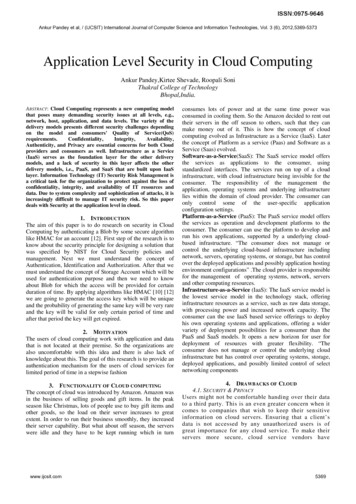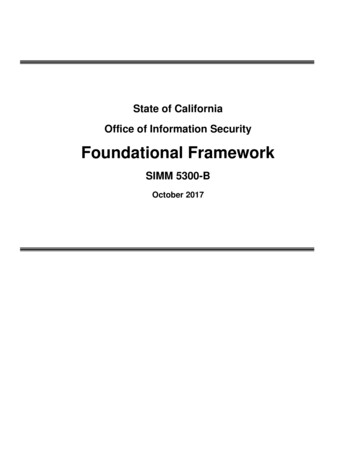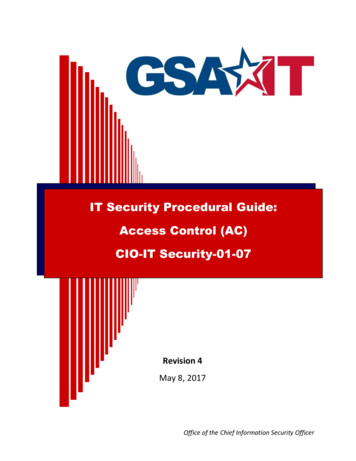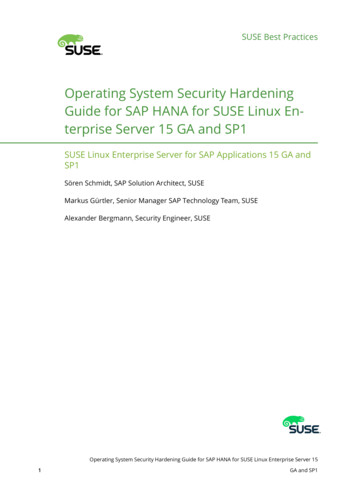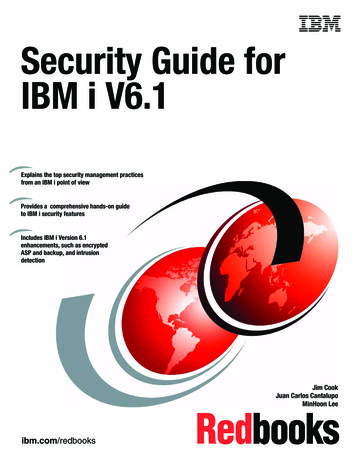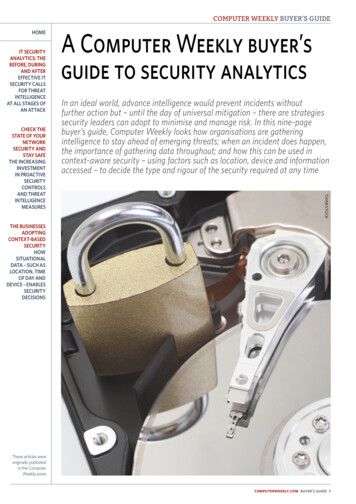
Transcription
Computer Weekly buyer’s GuideHomeIT securityanalytics: thebefore, duringand afterEffective ITsecurity callsfor threatintelligenceat all stages ofan attackIn an ideal world, advance intelligence would prevent incidents withoutfurther action but – until the day of universal mitigation – there are strategiessecurity leaders can adopt to minimise and manage risk. In this nine-pagebuyer’s guide, Computer Weekly looks how organisations are gatheringintelligence to stay ahead of emerging threats; when an incident does happen,the importance of gathering data throughout; and how this can be used incontext-aware security – using factors such as location, device and informationaccessed – to decide the type and rigour of the security required at any timeThinkstockCheck thestate of yournetworksecurity andstay safeThe increasinginvestmentin proactivesecuritycontrolsand threatintelligencemeasuresA Computer Weekly buyer’sguide to security analyticsThe naldata – such aslocation, timeof day anddevice – enablessecuritydecisionsThese articles wereoriginally publishedin the ComputerWeekly ezinecomputerweekly.com buyer’s guide 1
HomeIT securityanalytics: thebefore, duringand afterEffective ITsecurity callsfor threatintelligenceat all stages ofan attackIT security analytics:the before, during and afterCheck thestate of yournetworksecurity andstay safeThe increasinginvestmentin proactivesecuritycontrolsand threatintelligencemeasuresThe naldata – such aslocation, timeof day anddevice – enablessecuritydecisionsBig dataanalytics keyto crimefighting, saysMicrosoftSecurityanalytics toolsthat improvevisibilityEffective IT security calls for intelligence ahead of,during and following an attack, says Bob TarzeyBuyer’s guidesecurity analyticsThe scope of IT security analytics is broad. In an ideal world, threat intelligence,provided in advance, would prevent IT security incidents from occurring in the firstplace. However, complete mitigation will never be possible and incidents are inevitable, often with associated data breaches. Post-event clear up requires intelligencegathering, too. The quicker that can be done, the better; more chance of finding the smokinggun. The net result of trying to speed up incident response is that an increasing capability touse intelligence as an event is occurring. As one supplier, Cisco’s Sourcefire, puts it: the needfor security intelligence is “before, during and after” an incident.In the past, there have been distinct products in each area, but the boundaries betweenthem are blurring as suppliers extend their reach, in some cases competing with each otherwhere they previously did not, but also co-operating to share intelligence. The more timelythat intelligence can be gathered, the more likely it is that it will be put to use for proactivedefence, rather than post-event clear-up. This is the area of real-time security analytics.Blacklists and whitelistsFirst, let’s look at the before. Threat intelligence is the lifeblood of the IT security industry.It includes blacklists of common spam emails, malware signatures and dodgy URLs, as wellas whitelists of known good stuff (applications you want your users to run or websites youare happy for them to visit). All this is still a key part of protecting IT users and relies on thevast threat intelligence-gathering networks that sit at the core of most IT security companies. Examples include Cisco’s Advanced Malware Protection (from its Sourcefire acquisition, now integrated across the Cisco security portfolio); the Symantec Protection Network;McAfee’s Global Threat Intelligence; and Trend Micro’s Smart Protection Network.computerweekly.com buyer’s guide 2ThinkstockComputer Weekly buyer’s Guide
Computer Weekly buyer’s GuideHomeIT securityanalytics: thebefore, duringand afterEffective ITsecurity callsfor threatintelligenceat all stages ofan attackCheck thestate of yournetworksecurity andstay safeThe increasinginvestmentin proactivesecuritycontrolsand threatintelligencemeasuresThe naldata – such aslocation, timeof day anddevice – enablessecuritydecisionsAll IT security suppliers have access to such resources at some level. Part of the power ofthese networks is that they are kept up to date by gathering intelligence from, and sharing itwith, huge customer bases. However, many now accept that intelligence gathered before isnever going to stop the most insidious threats. However good such networks are, unwantedsecurity breaches will still occur.So let’s now look at what may need to be done after: the worst-case scenario, when anevent has occurred and systems and/or data have been compromised. The requirement nowis to understand the extent of the damage. This is the world of IT forensics: the preparing ofreports for internal investigations, responding to regulators and, in some cases, communicating with crime investigators. Examples of relevant incidents include the discovery of unknownmalware (which may or may not have been egressing data), evidence of hacking and, insome cases, the suspicious behaviour of employees.Clues to what has happenedMany nowWell-established suppliers of forensics include GuidanceSoftware, Access Data, Stroz Friedberg and Dellaccept thatForensics. In 2013, Guidance released a new version ofits Encase product, called Encase Analytics. Many ofintelligencethe clues to what has happened lie on the servers, storage systems and end-user devices, so although EncasegatheredAnalytics is a network-based tool, these end points arebefore isits focus. The volumes of data involved can be huge and,as Guidance puts it, this is where “big data meets digitalnever goinginvestigations”.To complete its reports, Encase Analytics needs kernelto stop thelevel access across multiple operating systems to inspectmost insidiousregistries, system data, memory, hidden data, and so on.Network and security appliance log files are also of use. Tothreatsaccess information from these, Guidance can take feedsfrom SIEM (security information and event management)tools, which are discussed below. Guidance has hundredsof enterprise customers that use its tools. One of the benefits is to be able to offer readycustomised reports for specific regulatory regimes, such as PCI/DSS, the UK Data ProtectionAct and the mooted EU Data Protection Law.Access Data’s Cyber Intelligence and Response Technology (CIRT) provides host andnetwork forensics as well as the trickier-to-address volatile memory, processing data collected from all these areas to provide a comprehensive insight into incidents. With some newcapabilities, Access Data is repackaging this as a platform it calls Insight to provide continuous automated incident resolution (CAIR).New capabilitiesThe new capabilities include improved malware analysis (what might this software havedone already; what could it do in the future?), more automated responses (freeing up staffto focus on exceptions) and real-time alerts. This is all well beyond historical forensics,moving Access Data from after to during, and even some before capability. Like Guidanceand other suppliers, Access Data relies on SIEM suppliers for some of its intelligence.In the past, SIEM has also typically been an after technology. Most SIEM suppliers comefrom a log management background, which is the collection and storage of data from network and security system log files for later analysis.Many of the major IT security suppliers have entered the SIEM market via acquisitions:HP of ArcSight in 2010, IBM of Q1 Labs in 2011, McAfee of Nitro Security in 2011, EMC’sRSA of Netwitness in 2011 and KEYW’s Hexis of Sensage in 2012. Other suppliers includeLogRhythm, Red Lambda and Trustwave. Splunk is often included in the list of SIEM suppliers,computerweekly.com buyer’s guide 3
Computer Weekly buyer’s GuideHomeIT securityanalytics: thebefore, duringand afterEffective ITsecurity callsfor threatintelligenceat all stages ofan attackCheck thestate of yournetworksecurity andstay safeThe increasinginvestmentin proactivesecuritycontrolsand threatintelligencemeasuresThe naldata – such aslocation, timeof day anddevice – enablessecuritydecisionsbut its focus is even broader, using IT operational intelligence for providing commercial aswell as security insight.As with forensics, the volumes of data are so big that SIEM is increasingly referred to asa “big data problem”. It fits the definition well, if you go by the five Vs of big data: volume,variety, velocity, value and veracity. There is certainly lots of data involved (volume) and itcomes from a range of sources (variety), often being enriched with data from other sources(for example, user and device information, content classifications data and threat intelligencenetworks). However, it is the increasing capability to use SIEM data in real time that ticks thevelocity box and this is turning SIEM into a during technology. Anything that minimises theimpact of security incidents clearly has value, and veracity comes from the truth exposedthrough deep insight.Plenty of measuresTo use intelligence from a range of sources in real timeto identify and mitigate threats as they occur is theholy grail of IT security. Of course, there are plentyof measures that can be taken: running suspiciousfiles in sandboxes (witness the rapid growth of supplier FireEye); only allowing known good files to run(for example, with white listing technology from Bit9,another supplier that has upped its ante for the during with its recent merger with Carbon Black); blocking access to dangerous areas of the web, which is aconstantly moving goal (URL filtering from Websense,Proofpoint and others); or judicious checking of content in use (content inspection and redaction fromClearswift and others in the data loss prevention/DLP sector).More extensive protectionTo useintelligencefrom a range ofsources in realtime to identifyand mitigatethreats is theholy grail ofIT securityThese are all point products that help towardsthe broader aspiration of real-time mitigation.Supplementing these with analytics across a widerange of sources during an attack provides more extensive protection. Examples are:n Identifying unusual traffic between servers, which can be a characteristic of undetectedmalware searching data stores;n Matching data egress from a device with access records from a suspicious IP address,user or location;n Preventing non-compliant movement of data (which may be simply down to an employeebeing ignorant of the rules);n Linking IT security events with physical security systems (for example, maintenance ofplant infrastructure restricted to certain employees known to be on the premises);n Identifying unusual access routes, (for example some databases are only normallyaccessed via certain applications and not directly by users).So, in general terms, the news is good. The suppliers that aim to protect IT infrastructureare upping the ante in the arms race with attackers. More and more are making use of theirability to process and analyse large volumes of data in real time to better protect IT systems.But the bad news is that there is no silver bullet and never will be. A range of security technologies will be required to provide state-of-the-art defences and there will be no standingstill. Those who would steal your data are moving the goalposts all the time and they will bedoing that before, during and after their attacks. nBob Tarzey is analyst and director at Quocirca.computerweekly.com buyer’s guide 4
Computer Weekly buyer’s GuideHomeIT securityanalytics: thebefore, duringand afterEffective ITsecurity callsfor threatintelligenceat all stages ofan attackCheck the state of networksecurity and stay safeMany organisations are planning to increase their investment in proactivesecurity controls and threat intelligence measures, says Heidi SheyThe naldata – such aslocation, timeof day anddevice – enablessecuritydecisionsIT securityanalytics: thebefore, duringand afterNetworkbased securitytops Europeanagendafor 2014ThinkstockCheck thestate of yournetworksecurity andstay safeThe increasinginvestmentin proactivesecuritycontrolsand threatintelligencemeasuresBuyer’s guidesecurity analyticsOrganisations are investing in proactive controls and intelligence to stay ahead ofemerging threats. Security services, wireless security, next-generation firewallsand advanced malware detection capability will see the most investment growthfrom a technology perspective, according to analysis of B2B survey data from Forrester’s Forrsights Security Survey, Q2 2013.The survey looked at budgeting and spending, security group responsibilities, networksecurity technology and services adoption in North American and European organisations for2013 to 2014 and revealed that 46% of organisations expect to increase their spending onnetwork security in that period.Network security typically involves significant investment once organisations factor in thecost of equipment plus maintenance and value-added services.As-a-service investmentsAs-a-service investments are focusing on firewalls and threat intelligence. Network firewallmonitoring or management and web application firewalls are the top two growth categories of network security technologies that organisations would like to have as a service,with 28% saying they plan to invest in either adoption or expansion in both technologies.Threat intelligence as a service is also a high-growth category, with 26% of organisationssaying investment in this service is in their adoption plans. Threat intelligence has emergedas a means by which security professionals can finally proactively prepare for, and respondto, attacks. According to the survey, 63% of security decision-makers say establishing orimproving threat intelligence capabilities is a top priority for their organisation.computerweekly.com buyer’s guide 5
Computer Weekly buyer’s GuideHomeIT securityanalytics: thebefore, duringand afterEffective ITsecurity callsfor threatintelligenceat all stages ofan attackThe top growth categories for 2013/14 network security technology adoption are wirelesssecurity, next-generation firewalls and advanced malware detection capabilities. Also, 35%of organisations expect to either adopt measures to address wireless security in the next 12months or expand or upgrade an existing implementation, while 32% expect to do the samefor next-generation firewalls and 29% for advanced malware detection capabilities.When asked how they would prefer to source network security technologies or services,57% of organisations said they prefer to source from a single vendor’s portfolio. Security prosare no longer looking for more point solutions to add to their already bloated security infrastructure; they want to simplify integration and management.Zero trust networkCheck thestate of yournetworksecurity andstay safeThe increasinginvestmentin proactivesecuritycontrolsand threatintelligencemeasuresThe naldata – such aslocation, timeof day anddevice – enablessecuritydecisionsSecurity analytics and network analysis and visibility (NAV)tools are key components of a zero-trust network. Businessexecutives demand data for decision-making, and securityakeprofessionals want situational awareness. Security informameasurestion management (SIM) tools are seen as a solution to fulfilboth needs but SIM is not being used to its full potential. Bigto embeddata and NAV tools for security analytics will provide theextra ingredients to overhaul SIM and move it from merelysecuritycompliance reporting to providing situational awareness formindednessboth the business and IT security.Almost 30% of organisations plan to invest (by expandingin the entireor upgrading a current implementation or by implementing anew system in the next 12 months) in security analytics, andcompany23% say the same for NAV.Using a zero-trust model as the basis for a data-centricsecurity approach can help organisations to foster growthand break down organisational silos around the teamsresponsible for security, infrastructure and operations, enterprise architecture, and so on.Take measures to embed security-mindedness in the entire company, from individual security contributors to the security team to all staff, to ensure the organisation is alert, astuteand prepared for any situation.Security technologies and tools are important, but they are not the only defence. In mostorganisations, the human aspect of security does not get the attention it deserves. Almosthalf of firms see the unavailability of security staff with the right skills as a major challenge,citing lack of security operation skills as the biggest problem. It is not easy to hire securitystaff with the right skills, and the demand for them continues to increase.“T-”Security skills trainingRegardless of the background or seniority of individual security contributors, there is astrong desire for continued personal development and growth. Some 45% of organisationsplan to increase their security skills training, and this number is likely to grow.Based on the survey data, IT security professionals are in a state of transition. Spendingappears to be business as usual, but there are rumblings of change on the horizon for network technology adoption. As firms embrace zero trust, investments will support thesesecurity architecture and operations initiatives. The data in this Forrester survey offers a viewof what North American and European enterprises are doing about network security.But while it is helpful to see what other companies are doing, it is critical not to become aslave to the data. Consider this benchmark as a guide, using the trends revealed as a startingpoint for analysing your own budget and technology adoption plans for network security. nHeidi Shey is a security and risk analyst at Forrester Research. This article is an extract from her report,Understand the state of network security: 2013 to 2014 (January 2014).computerweekly.com buyer’s guide 6
Computer Weekly buyer’s GuideHomeIT securityanalytics: thebefore, duringand afterEffective ITsecurity callsfor threatintelligenceat all stages ofan attackBusinesses are beginning toadopt context-based securityContext-based security uses situational information such as location, time of dayand device type to enable effective security decisions. Warwick Ashford reportsThinkstockCheck thestate of yournetworksecurity andstay safeThe increasinginvestmentin proactivesecuritycontrolsand threatintelligencemeasuresThe naldata – such aslocation, timeof day anddevice – enablessecuritydecisionsBuyer’s guideSecurity analyticsBusinesscontext stillmissing fromcontext-awaresecurityNewsandbox techwill help enablecontext-awareaccessIt is more than 10 years since context-aware security was proposed. The idea is simple:build a security system that can use factors such as location, device and the informationbeing accessed to decide the type and rigour of the security required. In theory,technology designed to use situational information – such as identity, location, time ofday, device type, business value of data and reputation – would enable security decisions thatare more effective, efficient and accurate.A decade on, technology and networks have evolved to the point where such a system ispossible and can be sold commercially. But judging the uptake of context-aware technologiesis difficult because it is not one platform or one application, says Adrian Davis, managingdirector, Europe for (ISC)².“We are seeing more suppliers offering context-aware products and some are alreadyoffering integration platforms, such as Cisco’s pxGrid,” he says. “But on the enterprise side,adoption seems to be slow, as other initiatives such as bring your own device (BYOD), cloudand cyber defence take priority and the lion’s share of limited budgets. Additionally, thesetechnologies may require significant investment and alterations in network infrastructure.”computerweekly.com buyer’s guide 7
Computer Weekly buyer’s GuideHomeIT securityanalytics: thebefore, duringand afterEffective ITsecurity callsfor threatintelligenceat all stages ofan attackCheck thestate of yournetworksecurity andstay safeThe increasinginvestmentin proactivesecuritycontrolsand threatintelligencemeasuresThe naldata – such aslocation, timeof day anddevice – enablessecuritydecisionsPopularisation of context-based securityWhile BYOD and cloud initiatives may take budgets away from context-based securityin some organisations, they are driving its adoption in others. The reason is that contextbased information security is becoming more important as cloud and mobile computingerase network perimeters that were previously rigid.Also, advances in data generation, collection and analysis are allowing networks to respondmore intelligently to fast-moving or unexpected situations. This is helping companies andbanks that have access and identity management systems to track anomalous behaviour sothey can distinguish potential data theft or fraud.The algorithms underpinning these systems are improving, and larger amounts of historicaldata are allowing for more finely calibrated context decisions, says Dave Clemente, a seniorresearch analyst with the Information Security Forum (ISF). “However, this is not just atechnical issue and the human element is a core part of the problem and the solution. Afterall, a human must decide what constitutes anomalous behaviour and design algorithmsaccordingly,” he says.A recent ISF report addresses this challenge and looks at methods for moving employeesbeyond basic security awareness and towards behavioural change. “As well as improvinggeneral security behaviours, one recommended action in particular – making systemsand processes as simple and user-friendly as possible – will improve context-basedinformation security by reducing the number of false positives generated when peoplecircumvent security procedures to more easily accomplish daily tasks,” says Clemente.“Context-based security is here to stay, and more intelligent networks are a natural responseto growing complexity.”Clemente believes information security professionals need to think about what systemstheir organisation needs and invest accordingly.But when it comes to deploying context-based security technologies, (ISC)²’s Davisrecommends enterprises first gain understanding of the business and security benefits ofcontext-aware security. Next, they need to agree criteria for success, plan the integrationof the technologies and identify a suitable pilot project to trial the technologies. The impactThe advantages of context-based accessA context-based access solution adjusts a person’s access rights for an enterprise network,based on the device used and from where access is being initiated. For example, someoneaccessing a corporate network from a corporate-owned PC located in corporate office spaceis likely to have full role-based access to that network and the data held within it. But if thatperson used their own smartphone from a coffee shop, a context-based access solution wouldrestrict access to email only. If the smartphone were equipped with one of the newer sandboxtechnologies, though, and access were from the person’s home, a context-based access solutionmight offer them a richer view of the network and services.Sandbox applications keep corporate data and applications separate from personal content,allowing for freer use of BYOD. These apps, alongside company policies governing where adevice can be used, will further impact the take-up of context-based access technologies. Butthe situation will only change if the corporate body decides the current access mechanisms donot offer sufficient granularity of control. These will need to be risk-based, taking into accountthe degree of mitigation that can be offered by various context-based access solutions andsandboxing technologies. But the question remains as to whether the body corporate is ready toassess the risk of their data and information.Peter Wenham is a committee member of the BCS Security Forum strategic panel and director ofinformation assurance consultancy Trusted Management.computerweekly.com buyer’s guide 8
Computer Weekly buyer’s GuideHomeIT securityanalytics: thebefore, duringand afterEffective ITsecurity callsfor threatintelligenceat all stages ofan attackof adopting context-aware security on the current IT and security architectures should beconsidered. “It may require that one or both architectures need to be revised to gain thegreatest benefit from adoption,” says Davis. “As the (ISC)² Common Body of Knowledgestates, the architecture provides the means to ensure that the implementation of securitycontrols is correct and verifiable.”Barriers to successOnce the trial is underway, the performance and success of context-aware technologiescan be measured and compared against the success criteria. But long-term success restson whether or not a system is deployed with sufficient management buy-in from therequired departments, says Robert Newby, an analystCheck theand managing partner at KuppingerCole UK.state of yourSuccess, he believes, also requires an understanding ofnetworkuppliers arethe processes a new system will be required to integratesecurity andstay safewith, the overhead of deployment and management, andscramblingThe increasingthe long-term costs.investment“Tools can be useful if part of a wider project, but thisto createin proactivehas to come as the result of a need, a set of requirementssecuritytechnologycontrolsfrom across the business. Without this buy-in, a tool justand threatgets left on the shelf,” says Newby.intelligencethat solves aAssuming all these requirements are met, he saysmeasuresthe business still faces the challenge of measuring theproblem whicheffect of a security system. For this, the first requirementThe Businessesmay not existis good governance. “This is often underestimated oradoptingmisunderstood, but it is the cornerstone of enterprisecontext-basedRobert Newby,securitysecurity,” says Newby.How“If you have a baseline you can reference consistently,situationalKuppingerCole UKrisk management and metrics suddenly becomedata – such aslocation, timerepeatable and meaningful, and the executive buy-in youof day andwere lacking to start your project is ingrained in policy,” he says.device – enablesHowever, Newby cautions that metrics do not just measure the effectiveness of technicalsecuritydecisionscontrols, but of processes and people-based controls, such as awareness and training. Again,he says, these should not be underestimated, as they are the mechanisms for reporting backto the executives who have sponsored your security projects.Once again, it comes back to the human factor. “Security could be described as managinghuman behaviour, which may include context if the behaviour is expected,” says Newby.But the hype around context-based security is focused on context rather than thisbehaviour, he says. “The marketing is technology-based, around the ability to create therequired contexts, without knowing whether they are required or not.”Newby believes suppliers are scrambling to create technology that solves a problem whichmay not yet exist: “The processes and people do not yet require the tools, and they willnot require them until governance is in place to changebehaviour.”› Enterprise slow to adopt context-based securitySome enterprises are good at applying governance,› Cloud deepens context-aware security needmeasuringrisk, implementing change in line with› Context is key to security, says Gartneroperational requirements, measuring control effectivenessand feeding this back into governance, but most are not, hesays: “Unfortunately for context-based security, it does not consider the business context ofsecurity, just the context of the users.”Until this can be fully integrated into workflows and business process, via governance, hebelieves context-based security will remain a useful marketing point without a proper set ofrequirements. Despite all the technological advances since context-based security was firstmooted, the vital element of business context is still missing. n“S”computerweekly.com buyer’s guide 9
Analytics is a network-based tool, these end points are its focus. The volumes of data involved can be huge and, as Guidance puts it, this is where "big data meets digital investigations". To complete its reports, Encase Analytics needs kernel-level access across multiple operating systems to inspect




